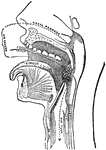Piston and Rod
"A piston and rod shown with attached weight. The valve, A, can be opened and closed as needed so that…

Air Pump
"The air pump is an instrument for removing air from a given space. A closed vessel R is called the…

Air Pump
"The air pump is an instrument for removing air from a given space. A closed vessel R is called the…

Air Pump
"The air pump is an engine by which the air can be pumped out of a vessel, or withdrawn from it. The…

Air Pump
"The piston rods are furnished with racks, or teeth, and are worked by the toothed wheel a, which is…

Air Pump
"The air pump is an instrument for removing a gas from a closed vessel, the essential parts are shown."…

Double Barrel Air Pump
"Crank M raises and lowers the two pistons C and D. The valves allow only for air to be removed from…

Diagrammatic view of an air sac
"A, epithelial lining wall; B, partition between two adjacent sacs, in which run capillaries;…

Cable Air Ship
An airship or dirigible is an aircraft that can be steered and propelled through the air using rudders…
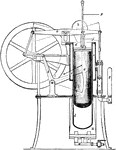
Air-engine
"A motor employing the elastic force of air expanded by heat, or air compressed by means of another…

Stirling's Air Engine
"A form of air-engine which was invented in 1816 by the Rev. R. Stirling is of special interest as embodying…

Air-Pump
"The general scheme of Geisler's pump is shown here. A and B are pear-shaped glass vessels connected…
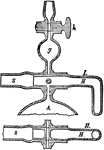
Air-Pump
"The general scheme of Geisler's pump is shown here. A and B are pear-shaped glass vessels connected…

Air-Pump
"This was invented in 1865 by H. Sprengel. The instrument, in its original (simplest) form, consists…

Barometer
"...being merely a tube of glass, nearly filled with mercury, with its lower end placed in a dish of…

Water Beetle Larva
Water beetles carry air bubbles under their abdomens, which provides an air supply. Water beetle larvae…

Blowpipe
An instrument by which a current of air or gas is driven through the flame of a lamp, candle, or gas…
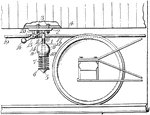
Air Brake
A conveyance braking system actuated by compressed air. Modern trains rely upon a fail-safe air brake…
Glass bulb
"An air thermometer consists essentially of a large glass bulb at the upper end of a tube of small but…

Centrifugal Blower
This blower has a drum consisting of two side plates and a series of partition plates curved in a cross…

Automatic Fan for Rocking Chair
This chair features a mechanical system that spins an idler gear while the user is rocking back and…

Common Guillemot
The Common Guillemot (Uria troile) is a member of the auk family. It breeds on all rocky coasts of the…
Compressed Air Manometer
"The compressed air manometer consists of a strong graduated glass tube of uniform narrow bore, closed…

Compressibility of Air
"Let P be a piston, fitted, air-tight, to the cylinder AB. As the piston is driven down, the air, unable…

Compression Experiment
"If the strong tube, or barrel, be smooth, and equal on the inside, and there be fitted to it the solid…

Air Compressor
"For many purposes compressed air is preferable to steam or other gas for use as a motive power. In…
Condenser
"The operation of the condenser is the reverse of that of the air pump, and is a much more simple machine.…
Condenser
"Air is pumped down through shaft A through a downward opening valve into a given chamber. Connector…

Solid core disk
"The metal cut away near the center reduces the weight and provides passages for air circulation." —…

Opposite Currents of Air
"Suppose a b c to represent a portion of the earth's surface a being towards the north pole, c towards…

Diving Dress
"The diving dress envelops the whole body of the diver, the upper portion a being the "helmet," the…

Dust Storm
A storm composed of sand. It occurs when the air over the sand becomes hot, and rises. The differences…
Kinnersley electrical air-thermometer
"Various methods have been devised for measuring electrostatic quantity, one of the simplest of which…
Two Objects Falling in a Vacuum
"Remove the air from a high glass tube by means of an instrument called the air-pump... Then... drop…

Funnel with Inverted Mercury Thermometer
"Pass the tube of an air thermometer or of an inverted mercury thermometer through a cork in the neck…

Globefish
"Tetraodon have a remarkable power of inflating their bodies by filling their stomachs with air, the…

Hargrave Kite
These Hargrave box kites are named so after their inventor, Lawrence Hargrave of Sydney. These kites…

Hydraulic Water Ram
"The hydraulic ram uses alternating water pressure, air pressure, and suction to provide a steady stream…

Java Kite
The tailless java kite resemble the kite used by Eddy of Bayonne, N.J. in 1890. This kite is tailess.

Land and Sea Breezes
During the day the land near the coast becomes warmer than the sea. An ascending current, therefore,…

Pondweed Leaf
"Vertical section of the leaf of Potamogeton or Pondweed, showing air cavities or lecunae l, and parenehymatous…

Liquid Air Machine
"A labratory liquid air machine used by Thomson and Joule used to cool hydrogen from a gaseous state…

Magdeburg Hemispheres
"Grease the edges to make more sure of a tight joint, fit the hemispheres to each other, and exhaust…

Origin of Winds
Winds are masses of air in motion. They resemble the currents in the ocean, and result from the same…
!["[This illustration] shows the path of a stone thrown obliquely from the hand. The propelling force sends it in a straight line to A, and would take it on in the same direction to B, were it not that, as soon as its velocity becomes sufficiently diminished, gravity and the air's resistance give it a circular motion to C, and finally bring it to the earth at D." —Quackenbos 1859](https://etc.usf.edu/clipart/36300/36322/proj_mot_36322_mth.gif)
Projectile Motion of a Stone
"[This illustration] shows the path of a stone thrown obliquely from the hand. The propelling force…

Refraction, air, water, glass
"Let a represent a, b water, and c a piece of glass. The ray d, striking each medium in a perpendicular…

Explanation of Refraction
"Thus, when erher waves that constitute light are transmitted through glass, they are hindered by the…

Refraction of Light Between Air and Water
"LA represents a ray of light propagated in air, falling obliquely upon the surface of the water at…
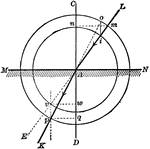
Refraction of Light Between Water and Air
"If the ray passes in the opposite direction, i.e., from water into air, the process is the reverse…

Roots in Soil
"Diagram to illustrate a root-hair (h) in the soil, and its relation to the soil-particles, the capillary…
